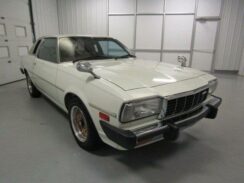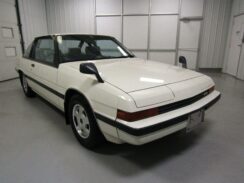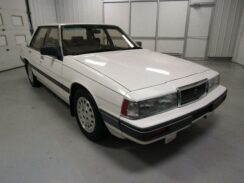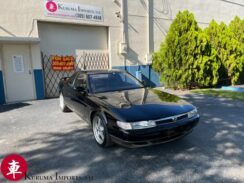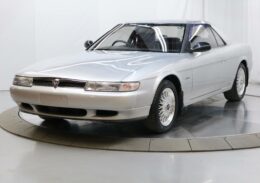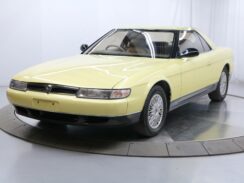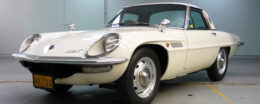
1990 Mazda Cosmo Coupe
Mazda Cosmo Buying Guide
If you thought the Mazda RX-7 or the Mazda Miata is the coolest Mazda you can own, there’s probably one you’ve never heard of, the Mazda Cosmo. But if you played Need For Speed (NFS) underground, you have an idea of what the Mazda Cosmo is.
In the late 1960s, Japanese manufacturers were going out of their way to make halo cars as a marketing strategy. The Mazda Cosmo was first produced as Mazda’s halo car in response to Toyota’s halo car, the Toyota 2000GT. But Nissan had already made their halo car in collaboration with Yamaha, the Yamaha YX30, earlier in 1961.
However, the Yamaha YX30 and the Toyota 2000GT are related since Nissan ditched Yamaha after they realized that the YX30 halo car didn’t meet their expectations. In 1964 Yamaha took the YX30 designs to Toyota, and Toyota built the 2000GT based on the Yamaha YX30.
So, the Mazda Cosmo remains the only purebred halo car that went to large-scale production, as the Toyota 2000GT was discontinued in 1970. The Nissan replaced the Yamaha YX30 with the Prince Skyline and the Nissan Fairlady.
Mazda independently designed and engineered the Mazda Cosmo equipping it with the first twin-rotary engine. From the second generation, Mazda began using 4-cylinder engines alongside twin-rotor engines. Production started in 1967, and part of the reason you’ve never seen a Mazda Cosmo is that it was never sold in the US.
The famous 13B engine was born in 1973, but Mazda used it in the Mazda REP (Rotary Engine Pickup) and the RX4 before using it in the Mazda Cosmo. Other rotary engines used in the Mazda Cosmo include the 12A, 12B, and 20B. Is a Mazda Cosmo better than a Mazda RX-7? Probably. But the RX-7 isn’t Cosmo’s main competitor.
Pros and Cons
Pros

Luxurious
If you are in the market for a JDM luxury sports coupe, you mainly revolve around the Toyota Soarer or the Honda (Acura) Legend. The Mazda Cosmo is not too common in the US. Still, it sits above the Soarer and Legend regarding luxury features.
The interior doesn’t give out much, but Mazda made the Cosmo a luxurious alternative to the RX-7. In the interior, everything is covered in leather. From the door trims to the gear selector knob. This might irk some, especially if you have kids who love jumping on the leather seats if you get one with a cream or white interior.

Some features, such as a satellite phone and touchscreen control, were optional on base trim models and standard on high-sped models. But the fact that Mazda used such features in the 90s makes Cosmo one of the most luxurious JDM cars. You might use the Navstar navigation system when your phone dies.
The first-gen Cosmo, Series L10A/L10B, is not at all luxurious by today’s standards. But if you get one that has been kept well, you’ll notice its excellent interior quality. It was not only built as a halo car but also as a race car. The interior has a mix of racing elements but maintains a clean, luxurious appeal with leather and wooden touches.
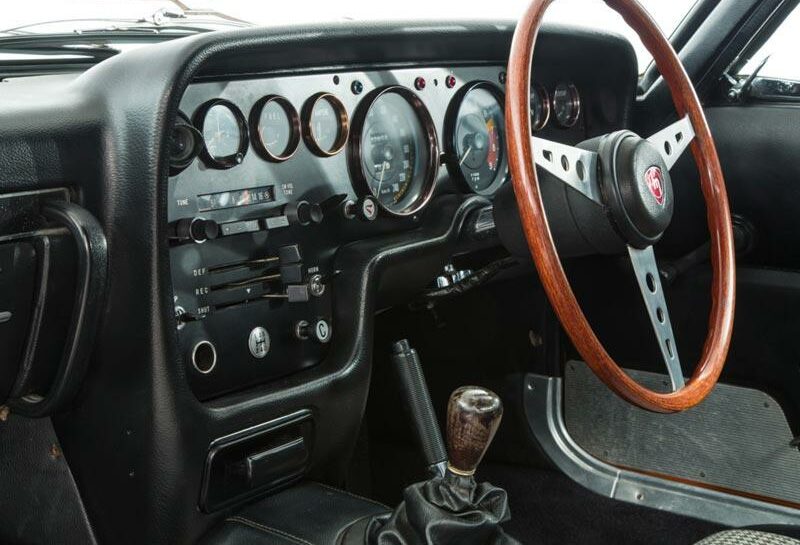
Rotary Power (High Revving)
Rotary (Wankel) engines are some of the best JDM engines ever made. Tuners and car enthusiasts will tell you not to buy a car with a rotary engine unless you are mentally and financially prepared to own one. This is true, but you have to look on the brighter side.
Rotary engines have a simpler build and thus are easy to modify and work on than piston engines. A simple build means fewer moving parts, resulting in a small, lightweight engine that can rev to over 7000RPM.
For a first-time owner, the best you can do is replace worn-out parts and keep the engine stock. You can easily achieve over 1000 horsepower from a 13B or 12A engine, but this is where things start to go downwards. These engines push around 130 to 250 horsepower when stock, which is still reasonable for a daily driven car.
With factory internals, you can achieve a maximum of 300 horsepower from a 13B or 20B engine. The 12A and 12B engines can handle a maximum of 250 horsepower.
Pushing 1200 horsepower from a Rotary engine is just as easy as in an RB or 2JZ engine but you’ll require other extensive modifications to handle such figures. The Mazda Cosmo might have low aftermarket support. Still, Rotary engines do as they are some of the most loved engines among tuners.
Unique

It’s easier to recognize a Mazda RX-7 than a Mazda Cosmo. When you pull up to a car meet 90% of the fans flashing cameras on your windows or under your engine bay are only there because they hear a rotary engine under the hood.
Mazda decided to let the world enjoy a car that was never meant for mass production, unlike Toyota, which made only 337 units of the 2000GT. Of all Mazda Cosmo units produced, 1176 belong to the first generation; series 1 (343) and series 2 (833). The first-gen Cosmo wouldn’t pull a crowd at a JDM car meet. But if you take it to a classic car show, photographers will be drooling all over to take a picture.
Highly Collectible
The Series I (L10A) and II (L10B) Mazda Cosmo are some of the highly collectible JDM cars. Both cars were produced in the first generation, but the Series 1 has a different engine from the Series II and is rarer. Also, Mazda registered two units in the 84-hour Marathon de la Route held at Germany’s legendary Nürburgring track.

A first-gen Mazda Cosmo is worth over $100,000, and its value increases over time. If you are waiting for a sign to buy one, this is it. But if you want to sell yours, hold on to it a little longer. Maybe its value might double or triple in the coming years.
Fun To Drive
Driving a Mazda Cosmo or any other car with a rotary engine is an experience every JDM lover should experience. When stock, there’s not much you can enjoy except waiting to hit the rev limit. But when you start chasing mods such as installing an aftermarket exhaust or intake, you’ll start appreciating the Mazda Cosmo more. You’ll forget about the gas mileage and send the car just like Johnny Hubert drove the Mazda 787B at Le Mans.
GT coupes aren’t meant to be drifted, but there’s nothing that should stop you from turning a Mazda Cosmo into a drift car. If a Mazda Miata can do it, a Mazda Cosmo can do it better. Some model years come with an LSD; the only thing remaining would be engine tuning, roll cage, and you can’t forget drift livery.
Cons
Poor Paint Quality
Paint cracks and chippings are ordinary on older cars, and the Mazda Cosmo is no exception. Since you can’t avoid such, the best solution is to repaint the whole car or just the worst affected parts. Repainting helps avoid rust which eats deep into the body panels. It is also advisable to peel off some paint surrounding the affected area to check the extent of the damage.
High Oil and Fuel Consumption
If you ask any JDM enthusiast why they will buy any other car apart from a Mazda with a rotary engine, they’ll tell you those cars chug oil and fuel more than a field tractor. Which is true, but not as much as a farm tractor. Rotary engines require more maintenance than your average piston engine.
Rebuilding the engine is the first thing that comes to mind after buying a car with a Rotary engine. But does it work? Well, it will improve fuel and oil consumption compared to before the engine was rebuilt. The engine hasn’t been worked on in the last 40 years, give or take.
So, what causes rotary engines to consume more fuel and oil than average? The combustion chamber design is the biggest letdown as it has low thermal efficiency. This means that not all fuel and air get combusted, leading to the unburnt fuel leaking into the exhaust manifold and out of the exhaust, causing backfires. If you enjoy backfires or are a crowd pleaser at a car meet, you’ll empty your gas tank in no time.
The apex seals on rotary engines need to be constantly lubricated; thus, oil is directly injected into the combustion chamber. If you notice oil consumption higher than normal in your Mazda Cosmo, you must replace the apex seals. The older they are, the more oil the engine consumes. If you notice a fuel smell after an oil change, there’s nothing to worry about, as this is common in rotary engines.
Common Issues

Engine Carbon Deposits
If you decide to buy a Mazda Cosmo, you should be prepared for carbon buildup on a 13B, 20B, or any other rotary engine. However, this issue is more common in the 13B engine than in any other rotary engine. Engine oil is injected into the combustion chamber to lubricate the apex seals.
The oil in the combustion chamber carbonizes due to the excess heat after fuel and air are combusted. Also, rotary engines have a low thermal point, leading to unburnt fuel in the combustion chamber. The mixture between the unburnt fuel and hot oil also leads to carbon deposits.
Exhaust gases on piston engines can eliminate some of the carbon deposits. This is impossible in rotary engines because the combustion chamber design and the carbon deposits will build up on the rotor faces, side seals, spark plugs, and even the O-rings.
Rebuilding the engine every once in a while is recommended to prevent excessive carbon buildup. You can also use synthetic oil or use a carbon cleaner when changing the oil.
Worn-out Apex Seals
Besides the high fuel and oil consumption of Mazda Cosmo, RX-7 and RX-8 owners will complain about how often they have to change the apex seals. Some will even tell you they have a couple lying around in the car or their garages since you don’t know when the apex seals will blow.
The apex seals are located in the combustion chamber and thus are constantly subjected to high temperatures, degrading their usability. They also need constant lubrication, so if the engine oil level is low, they wear out quicker than expected.
Loss of power, misfires, and engine stalling are some early signs of apex seal failure. Changing all apex seals is recommended, so you get a changing rotational schedule for all instead of just one apex seal.
To increase the lifespan of the apex seals, ensure that the engine oil is always at the required capacity. Also, stronger aftermarket apex seals with better retainer springs help maintain compression in the combustion chamber.
Catalytic Converter Failure
Part of the reason why you’ll find a Mazda RX-7 or RX-8 get pulled over is that it didn’t pass an emission test. If you decide to get a Mazda Cosmo soon, that will be you. Rotary engines have two catalytic converters similar to the pre-catalytic converter and main catalytic converter setup found in Nissan VH and VQ engines.
One is located within the downpipe, and the other is found just after the first exhaust hanger under the widened part of the windshield. Catalytic converter failure occurs on all rotary engines, but it’s more common in the 13B with the twin-turbo setup.
Excess heat from the turbochargers breaks up the first catalytic converter, which clogs the second one. As a result, the unfiltered air circles back into the engine, causing it to produce more emissions. Both catalytic converters can be removed. Then replace the second one with a better aftermarket one. A single catalytic converter is not illegal if the car passes an emissions test.
Cracked Turbo Manifold (Switch from twin turbo to single turbo)
One of the biggest disadvantages of old turbocharged engines is a cracked turbo manifold. This mostly occurs in cars with motorsport history, and the Mazda Cosmo might not seem like much, but you have to be careful when buying one.
The turbo manifold on the 13B engine is subjected to constant temperature fluctuations. These fluctuations cause the metallic engine manifold to warp and crack over time. You might be able to live with a cracked turbo manifold, but if you are planning on increasing the engine’s power output, it needs replacing.
Rust
Rust is one of the main things to look out for when buying a car as old as a Mazda Cosmo. Surface rust is not bad but only to a certain degree. Common rust spots in a Mazda Cosmo include underneath the trunk and floor padding.
Average Prices

The Mazda Cosmo has a similar price to the RX-7, depending on the model year. Prices start at $25,000 for the Series JC (1990-1996). Trims with the 20B engine cost a little bit more at approximately $30,000. Older model years are cheaper since you can pick one up for less than 20,000 with a 13B, 12A, or 12B engine.
You’ll have to dig deeper into your pockets if you want to buy a Series 1 or II Mazda Cosmo. The least you can pay for one in good condition is $100,000, while fixer-upper units will cost you twice the price of a JC Mazda Cosmo.
Comparable Alternatives
- Nissan Skyline (Read the Complete Skyline Buying Guide)
- Nissan Fairlady Z (Read our Buying Guide)
- Mazda RX-7 (Read our Buying Guide)
- Toyota Soarer (Read our Buying Guide)
- Nissan Silvia (Read our Buying Guide)
- Toyota Supra (Read our Buying Guide)
- Honda Legend
Models and Specifications
1967-1972 Mazda Cosmo (L10A, L10B)

In 1964 Mazda decided to make a Halo car which they would reveal at the 1964 Tokyo Motor show. They adopted the Wankel engine from Felix Wankel, who had designed it earlier in 1929. When the first two engines were developed, the large-scale production of the engine didn’t happen until 1951 when NSU Motorwerke (NSU motor works), a German car manufacturer.
Mazda and NSU collaborated to bring the first rotary engine-powered cars to the automotive industry. When NSU made the NSU Spider in 1964, Mazda installed their prototype rotary engine in the Mazda Cosmo. Both cars were revealed at the 1964 Motor show.
In 1965 Mazda built 80 units of the Mazda Cosmo, 20 for their test department and 60 for dealership testing. Production of customer units began in 1967 with the Series 1 with the 0810 engine, while the Series II was produced in 1968 with the 0813 engine.
The 0810 engine made 110 horsepower while the 0813 made 130 horsepower. Another difference between the two is that Series 1 has a 4-speed manual transmission while Series 2 has a 5-speed manual transmission. The series 2 is also 150mm longer than the Series one with a 2,350 mm-long wheelbase.
Mazda also built two racing units for the 1964 84-hour Marathon de la Route. Their main aim was not to win but to test their rotary engines’ durability and reliability. The Japanese team didn’t win, but one Cosmo driven by the Belgian team clinched the third runner-up.
The Mazda Cosmo sold well in Japan as customers got more powerful cars than those powered by piston engines which were heavier and faced higher road taxes. The race cars inspired the Series II Cosmo, as Mazda made it better from the data based on the race results. No other Cosmo race cars were built as production was focused on customer production units.
1975-1981 Mazda Cosmo (CD)

The second-gen Mazda Cosmo, Series CD, was unveiled in 1975. But since the 12A engine was new, it was first sold with two 4-cylinder engines, a 1.8-liter, and a 2.0-liter engine. Mazda Couldn’t use the 13A engine since it was made for front-wheel-drive cars only, and the Cosmo is rear-wheel-drive.
Unlike the first-gen Cosmo, which was only sold with a manual transmission, Mazda introduced a 3-speed and 4-speed automatic transmission. But most units were sold with either a 4-speed or 5-speed manual transmission.
Later that year, the 12A engine was introduced in the Mazda Cosmo. Export variants still used the 4-cylinder engines, but low sales made Mazda halt the exportation of the Cosmo. In Japan, the Mazda Cosmo was loved. Mazda made a luxury coupe with opera windows and a vinyl roof to compete against the Toyota Crown, Nissan Cedric, and Nissan Gloria Coupes.
Few units were made with the 13B engine as it was used more in the Mazda RX-7, being sportier than the Mazda Cosmo. However, the 13B engine used in the Cosmo is more powerful than the one used in the 1978 RX7.
1981-1987 Mazda Cosmo (HB)

Mazda introduced a new 2.0-liter 4-cylinder engine, two new rotary engines, and a turbocharged 12A and 13B RESI (Rotary Engine Super Injection). The 13B RESI uses an upgraded intake manifold with a supercharger-like effect. Mazda also upgraded the fuel injection system to a Bosch L-Jetronic fuel injection, increasing horsepower to 135 from 120 in the standard 13B engine.
Like the Series CD, you also get a 4/5-speed manual or 3/4-speed automatic transmission. The Series HB was also made with a rear-wheel drive platform, and a new sedan model was introduced.
The dual circular headlights were replaced with dual rectangular pop-up headlights, which were common in cars produced in the late 1970s and early 1980s. However, they were only used on coupes, and sedans come with mono-piece rectangular headlights.
Models with the turbocharged 12A engine were badged as the Mazda Cosmo Rotary turbo. The Mazda Cosmo Rotary Turbo coupe was the fastest car in Japan but was kicked out by the Nissan Skyline R30 RS. The Cosmo Rotary Turbo sedan is one of the best sleeper cars you can buy on a budget.
1990-1996 Mazda Cosmo (JC)

The last-gen Cosmo, Series JC, was produced by Eunos, among Mazda’s subsidiary units, but was shut down in 1996. After Eunos merged with Efini, a Mazda luxury unit, they turned the Cosmo into one of the best JDM sports coupes rivaling the Toyota Soarer.
You get the JC Cosmo with the only 3-rotor engine fitted into a production car, the 20B-REW. You can also get one with the twin-turbocharged 13B-RE. However, both engines were limited to 280 horsepower and 180km due to the Gentlemen’s Agreement of 1988. However, fewer units were made with the 20B-REW since only 3550 units were made out of the 8875 units.
Suppose you are looking to buy a Mazda Cosmo. In that case, the last generation is the best you can buy, regardless of the unavailability of a manual transmission. You get it with features only available in JDM VIP sedans such as the Mazda Sentia or Toyota Century. Such features include a satellite navigation system, a signal TV, and a touchscreen infotainment system that was cutting-edge technology in the 1990s. The Mazda Cosmo was discontinued in 1996 when Eunos and Efini were shut down.
FAQ
If reliability translates to excellent fuel consumption, then we can’t say that the Mazda Cosmo is reliable. However, with stock components, a Mazda Cosmo will last around 20,000 miles with regular maintenance before you need to replace major mechanical parts.
Prices for the Mazda Cosmo start at around $25,000 if you want one with a 13B or 20B engine. Depending on the model year, trims with other engines go for approximately $20,000.
Yes, all Mazda Cosmo model years are legal for import to the US.
The Mazda Cosmo was the first Mazda to feature a rotary engine. However, you can also get one with a 4-cylinder piston engine.
You get the Mazda Cosmo with various rotary engines such as the 12A, 13B, and 20B engines. If you are buying one that was made between 1975 to 1987, there’s a probability that it has a 4-cylinder piston engine.
How to Import a Mazda Cosmo
Read our Ultimate Guide on How to Import a Car from Japan.
